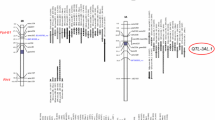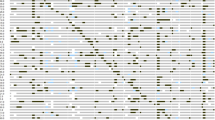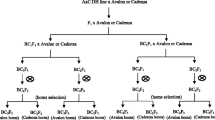Abstract
Quantitative trait loci (QTLs) controlling yield and yield components were identified by using a doubled haploid (DH) population of 120 lines from a sub-specific cross between ‘Samgang’ (Indica) and ‘Nagdong’ (Japonica). Main effects, epistatic effects, their environment interactions of QTLs were analyzed via mixed linear model approach across different environments. A total of 17 putative QTLs were identified on 8 chromosomes and five QTLs were detected over two years. 7 QTLs of main effects and 23 epistatic interactions were observed for five traits. Epistatic interactions played an important role in controlling the expression of yield related traits. The epistatic effects explained higher percentages of phenotype variation for panicles per plant, seed set percentage and yield. Significant QTL×environment (QE) interactions effects were identified for all traits, including 5 main effect QTLs. However, the present study failed to identify the significant interactions between epistatic loci containing main effect QTLs and the environment. The information provided in the present study could be used in the marker-assisted selection to enhance selection efficiency and to improve yield in rice.
Similar content being viewed by others
References
Ashikari M, Sakakibara H, Lin S, Yamamoto T, Takashi T, Nishimura A, Angeles ER, Qian Q, Kitano H and Matsuoka M (2005) Cytokinin oxidase regulates rice grain production. Science 309: 741–745.
Basten CJ, Weir BS and Zeng ZB (2005) QTL Cartographer, version 1.17.
Beavis WD, Grant D, Albertsen M and Fincher R (1991) Quantitative trait loci for plant height in four maize populations and their associations with qualitative genetic loci. Theor. Appl. Genet. 83: 141–145.
Berke TG, Baenziger PS and Morris R (1992) Chromosomal Location of Wheat Quantitative Trait Loci Affecting Agronomic Performance of Seven Traits, Using Reciprocal Chromosome Substitutions. Crop Sci. 32: 621–627.
Brondani C, Rangel N, Brondani V and Ferreira E (2002) QTL mapping and introgression of yield-related traits from Oryza glumaepatula to cultivated rice (Oryza sativa) using microsatellite markers. Theor. Appl. Genet. 104: 1192–1203.
Burr B, Burr FA, Thompson KH, Albertson MC and Stuber CW (1988). Gene mapping with recombinant inbreds in maize. Genetics 118: 519–526.
Campbell BT, Baenziger PS, Gill KS, Eskridge KM, Budak H, Erayman M, Dweikat I and Yen Y (2003) Identification of QTLs and Environmental Interactions Associated with Agronomic Traits on Chromosome 3A of Wheat. Crop Sci. 43: 1493–1505.
Cho YG, Kang HJ, Lee JS, Lee YT, Lim SJ, Gauch H, Eun MY and McCouch SR (2007) Identification of Quantitative Trait Loci in Rice for Yield, Yield Components, and Agronomic Traits across Years and Locations. Crop Sci. 47: 2403–2417.
Fasoulas AC and Allard RW (1962) Nonallelic Gene Interactions in the Inheritance of Quantitative Characters in Barley. Genetics 47: 899–907.
Frary A, Nesbitt TC, Grandillo S, Knaap E, Cong B, Liu J, Meller J, Elber R, Alpert KB and Tanksley SD (2000) fw2.2: a quantitative trait locus key to the evolution of tomato fruit size. Science 289: 85–88.
Ge XJ, Xing YZ, Xu CG and He YQ (2005) QTL analysis of cooked rice grain elongation, volume expansion, and water absorption using a recombinant inbred population. Plant Breed. 124: 121–126.
Guo LB, Xing YZ, Mei HW, Xu CG, Shi CH, Wu P and Luo LJ (2005) Dissection of component QTL expression in yield formation in rice. Plant Breed. 124: 127–132.
Hua JP, Xing YZ, Wu WR, Xu CG, Sun XL, Yu SB and Zhang QF (2003) Single-locus heterotic effects and dominance by dominance interactions can adequately explain the genetic basis of heterosis in an elite rice hybrid. Proc. Natl. Acad. Sci. USA 100: 2574–2579.
Ishimaru K (2003) Identification of a locus increasing rice yield and physiological analysis of its function. Plant Physiol. 133: 1083–1090.
Kato K, Miura H and Sawada S (2000) Mapping QTLs controlling grain yield and its components on chromosome 5A of wheat. Theor. Appl. Genet. 101: 1114–1121.
Kobayashi S, Fukuta Y, Yagi T, Sato T, Osaki M and Khush GS (2004) Identification and characterization of quantitative trait loci affecting spikelet number per panicle in rice (Oryza sativa L.). Field Crops Res. 89: 253–262.
Lee SJ, Oh CS, Suh JP, McCouch SR and Ahn SN (2005) Identification of QTLs for domestication-related and agronomic traits in an Oryza sativa×O. rufipogon BC1F7 population. Plant Breed. 124: 209–219.
Li ZK, Pinson SR, Park WD, Paterson AH and Stansel JW (1997) Epistasis for three grain yield components in rice (Oryza sativa L.). Genetics 145: 453–465.
Liang F, Deng Q, Wang Y, Xiong Y, Jin D, Li J and Wang B (2004) Molecular marker-assisted selection for yield-enhancing genes in the progeny of “9311×O. rufipogon” using SSR. Euphytica 139: 159–165.
Lin HX, Qian HR, Zhuang JY, Lu J, Min SK, Xiong ZM, Huang N and Zheng KL (1996) RFLP mapping of QTLs for yield and related characters in rice (Oryza sativa L.). Theor. Appl. Genet. 92: 920–927.
Lincoln S, Daley M and Lander E (1992) Constructing genetic maps with MAPMAKER/EXP 3.0. Whitehead Institute technical report, 3rd edn.
Liu G, Zhang Z, Zhu H, Zhao F, Ding X, Zeng R, Li W and Zhang G (2008) Detection of QTLs with additive effects and additive-by-environment interaction effects on panicle number in rice (Oryza sativa L.) with single-segment substitution lines. Theor. Appl. Genet. 116: 923–931.
McCouch SR and Doerge RW (1995) QTL mapping in rice. Trends Genet. 11: 482–487.
Moncada P, Martinez CP, Borrero J, Chatel M, Gauch H, Guimaraes E, Tohme J and McCouch SR (2001) Quantitative trait loci for yield and yield components in an Oryza sativa×Oryza rufipogon BC2F2 population evaluated in an upland environment. Theor. Appl. Genet. 102: 41–52.
Nagata K, Fukuta Y, Shimizu H, Yagi T and Terao T (2002) Quantitative Trait Loci for Sink Size and Ripening Traits in Rice (Oryza sativa L.). Breed. Sci. 52: 259–273.
Paterson A, Damon S, Hewitt J, Zamir D, Rabinowitch H, Lincoln S, Lander E and Tanksley SD (1991) Mendelian factors underlying quantitative traits in tomato: comparison across species, generations, and environments. Genetics 127: 181–197.
Paterson AH, Lander ES, Hewitt JD, Peterson S, Lincoln SE and Tanksley SD (1988) Resolution of quantitative traits into Mendelian factors by using a complete linkage map of restriction fragment length polymorphisms. Nature 335: 721–726.
Qin Y, Kim SM and Sohn JK (2008) Detection of main effect QTLs, epistatic QTLs and QE interactions for grain appearance of brown rice (Oryza sativa L.). J. Crop Sci. Biotech. 11: 151–156.
Rahman ML, Chu SH, Choi MS, Qiao YL, Jiang W, Piao R, Khanam S, Cho YI, Jeung J, Jena KK, et al. (2007) Identification of QTLs for some agronomic traits in rice using an introgression line from Oryza minuta. Mol. Cells 24: 16–26.
Redoña ED and Mackill DJ (1998) Quantitative trait locus analysis for rice panicle and grain characteristics. Theor. Appl. Genet. 96: 957–963.
Roeder MIS, Huang XQ and Boerner A (2008) Fine mapping of the region on wheat chromosome 7D controlling grain weight. Funct. Integr. Genomics 8: 79–86.
Song XJ, Huang W, Shi M, Zhu MZ and Lin HX (2007) A QTL for rice grain width and weight encodes a previously unknown RING-type E3 ubiquitin ligase. Nat. Genet. 39: 623–630.
Tan LB, Zhang PJ, Liu FX, Wang GJ, Ye S, Zhu ZF, Fu YC, Cai HW and Sun CQ (2008) Quantitative trait loci underlying domestication- and yield-related traits in an Oryza sativa×Oryza rufipogon advanced backcross population. Genome 51: 692–704.
Tanksley SD and Nelson JC (1996) Advanced backcross QTL analysis: a method for the simultaneous discovery and transfer of valuable QTLs from unadapted germplasm into elite breeding lines. Theor. Appl. Genet. 92: 191–203.
Thomson MJ, Tai TH, McClung AM, Lai XH, Hinga ME, Lobos KB, Xu Y, Martinez CP and McCouch SR (2003) Mapping quantitative trait loci for yield, yield components and morphological traits in an advanced backcross population between Oryza rufipogon and the Oryza sativa cultivar Jefferson. Theor. Appl. Genet. 107: 479–493.
Veldboom LR and Lee M (1994) Molecular-marker-facilitated studies of morphological traits in maize. II: Determination of QTLs for grain yield and yield components. Theor. Appl. Genet. 89: 451–458.
Wang DL, Zhu J, Li ZK and Paterson AH (1999) Mapping QTLs with epistatic effects and QTL×environment interactions by mixed linear model approaches. Theor. Appl. Genet. 99: 1255–1264.
Xiao J, Li J, Grandillo S, Ahn SN, Yuan L, Tanksley SD and McCouch SR (1998) Identification of trait-improving quantitative trait loci alleles from a wild rice relative, Oryza rufipogon. Genetics 150: 899–909.
Xie X, Jin F, Song MH, Suh JP, Hwang HG, Kim YG, McCouch SR and Ahn SN (2008) Fine mapping of a yield-enhancing QTL cluster associated with transgressive variation in an Oryza sativa × O. rufipogon cross. Theor. Appl. Genet. 116: 613–622.
Xing YZ, Tan YF, Hua JP, Sun XL, Xu CG and Zhang QF (2002) Characterization of the main effects, epistatic effects and their environmental interactions of QTLs on the genetic basis of yield traits in rice. Theor. Appl. Genet. 105: 248–257.
Xu JL, Yu SB, Luo LJ, Zhong DB, Mei HW and Li ZK (2004) Molecular dissection of the primary sink size and its related traits in rice. Plant Breed. 123: 43–50.
Yao FY, Xu CG, Yu SB, Li JX, Gao YJ, Li XH and Zhang QF (1997) Mapping and genetic analysis of two fertility restorer loci in the wild-abortive cytoplasmic male sterility system of rice (Oryza sativa L.). Euphytica 98: 183–187.
Yoon DB, Kang KH, Kim HJ, Ju HG, Kwon SJ, Suh JP, Jeong OY and Ahn SN (2006) Mapping quantitative trait loci for yield components and morphological traits in an advanced backcross population between Oryza grandiglumis and the O. sativa japonica cultivar Hwaseongbyeo. Theor. Appl. Genet. 112: 1052–1062.
You A, Lu X, Jin H, Ren X, Liu K, Yang G, Yang H, Zhu L and He G (2006) Identification of quantitative trait loci across recombinant inbred lines and testcross populations for traits of agronomic importance in rice. Genetics 172: 1287–1300.
Yu SB, Li JX, Xu CG, Tan YF, Gao YJ, Li XH, Zhang QF and Saghai Maroof MA (1997) Importance of epistasis as the genetic basis of heterosis in an elite rice hybrid. Proc. Natl. Acad. Sci. USA 94: 9226–9231.
Zeng ZB (1994) Precision mapping of quantitative trait loci. Genetics 136: 1457–1468.
Zhang ZH, Li P, Wang LX, Hu ZL, Zhu LH and Zhu YG (2004) Genetic dissection of the relationships of biomass production and partitioning with yield and yield related traits in rice. Plant Sci. 167: 1–8.
Zhuang JY, Fan YY, Rao ZM, Wu JL, Xia YW and Zheng KL (2002) Analysis on additive effects and additive-by-additive epistatic effects of QTLs for yield traits in a recombinant inbred line population of rice. Theor. Appl. Genet. 105: 1137–1145.
Zhuang JY, Lin HX, Lu J, Qian HR, Hittalmani S, Huang N and Zheng KL (1997) Analysis of QTL×environment interaction for yield components and plant height in rice. Theor. Appl. Genet. 779: 799–808.
Author information
Authors and Affiliations
Corresponding author
Rights and permissions
About this article
Cite this article
Zhao, X., Qin, Y. & Sohn, JK. Identification of main effects, epistatic effects and their environmental interactions of QTLs for yield traits in rice. Genes Genom 32, 37–45 (2010). https://doi.org/10.1007/s13258-010-0786-y
Received:
Accepted:
Published:
Issue Date:
DOI: https://doi.org/10.1007/s13258-010-0786-y




